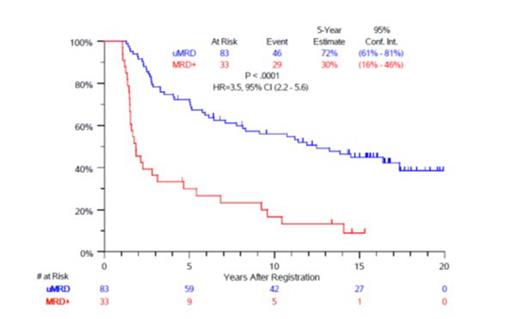Background. FL is associated with a heterogeneous clinical course, and currently available prognostic indicators are unable to reliably separate patients who exhibit early therapy resistance (POD24, defined as progression within 24 months from diagnosis) from those who achieve “functional cure” following initial therapy. NGS methods developed in recent years enabled quantification of MRD. The ClonoSeq assay (Adaptive Biotechnology, Inc.) has been FDA-cleared to track MRD in several hematologic malignancies. Here we demonstrate that MRD analysis by ClonoSeq assay predicts outcomes in a prospective cohort of patients with advanced stage FL enrolled on SWOG S0016 clinical trial.
Methods. SWOG S0016 was a phase III randomized study that compared the safety and efficacy of R-CHOP (rituximab, cyclophosphamide, doxorubicin, vincristine, prednisone) with CHOP-RIT (CHOP + I 133-tositumomab) in patients with FL. Between 2001 and 2008, 531 patients with previously untreated advanced-stage FL (bulky stage II, III-IV) of any pathologic grade were randomly assigned to receive 6 cycles of R-CHOP or CHOP-RIT. We used high-throughput sequencing (HTS) of the IGH and IGK/L loci (ClonoSeq assay) from tumor biopsy specimenstaken prior to treatment to define CDR3 rearrangements that tag the tumor. Subsequently, 1-year bone marrow specimens were screened for residual disease. The baseline dominant clone was defined as ≥10 estimated number of genomes (ENG) and comprised ≥5% of the library. MRD-positive state (MRDp) was defined as a minimum Hamming distance (HD) ≤6 in a patient's post-library (in any clone also detected in a pre-library) and conserved pre-existing SHM (if HD>0). Undetectable MRD (MRDu, at <10 -4) was defined as CRD3 HD>6 in a post-library with a depth >10,000 ENG. Five-year progression-free survival was the primary endpoint (PFS; defined as the time from registration to the first observation of progression or death due to any cause). Landmark analysis was defined at 1 year after registration and used for imputing the 5-year PFS and OS. Overall survival (OS) was defined as the time from registration to date of death due to any cause or last follow-up. PFS and OS estimates and 95% confidence interval were calculated using the Kaplan-Meier method and compared for MRDp and MRDu disease using two-sided log-rank test. HR and 95% CI were calculated using Cox regression model.
Results. Tumor biopsy tissue was available for 189 patients. Of these, 24 patients were not evaluable (16 did not consent for banking, 6 were ineligible and 4 had an early event). In 36 patients, pre-libraries did not yield a trackable clone. In total, MRD status could not be ascertained in 47 patients due to absence of a clear trackable clone in either pre- or post-library, contributing to a 28.8% failure rate. Of 116 patients which yielded a trackable clone in both libraries, 83 were MRDu and 33 were MRDp. Baseline characteristics (age, sex, race, β2M, B symptoms, bulky disease, grade 3, stage, and FLIPI risk) were similar between MRDp and MRDu patients; however, MRDp patients were more likely to exhibit morphologic baseline bone marrow involvement by FL (82% vs. 55%, p=0.01). The estimated 5-year PFS was 72% in MRDu patients and 30% in MRD+ patients (Figure); 10-year PFS was 56% and 17%, correspondingly. Meanwhile, 5-year OS was not different (96% for MRDu, 81% for MRD+, p=0.91). Patients with MRDu had a significantly higher best overall response rate than MRDp patients (96% vs 79%, p=0.005), but complete response (CR) rates were similar (41% vs. 30.3%). Patients who received CHOP-RIT had better PFS regardless of MRD status (HR=0.48, p=0.01 for MRDu; HR=0.38, p=0.02 for MRDp), while OS was not statistically different. Five-year PFS was superior in patients who achieved MRDu (75% for CR and 70% for PR) compared with MRDp patients, regardless of response (34%). Patients who had MRDp status had a significantly increased risk of experiencing POD24 relative to MRDu patients (RR=6.5, 95% CI 3.0-14.0; p<0.0001).
Conclusion. Here we for the first time demonstrate that MRDu status, as assessed by Clonoseq, predicts improved 5- and 10-year PFS in patients with FL initially treated with chemoimmunotherapy. MRD+ status in the bone marrow at a 1-year timepoint was associated with POD24. Despite a relatively high failure rate to detect trackable sequences using current technology (~29%), MRD assessment by NGS is a promising prognostic tool in FL.
*co-senior authors
Disclosures
Danilov:Bayer: Research Funding; Astra Zeneca: Consultancy, Research Funding; Bristol Meyers Squibb: Consultancy, Research Funding; Beigene: Consultancy, Research Funding; Janssen: Consultancy; Cyclacel: Research Funding; MEI: Consultancy, Research Funding; Genentech: Consultancy; Abbvie: Consultancy, Research Funding; Nurix: Consultancy, Research Funding; GenMab: Consultancy, Research Funding; Merck: Consultancy; Lilly Oncology: Consultancy, Research Funding. Shadman:AstraZeneca: Consultancy, Research Funding; Pharmacyclics: Consultancy, Research Funding; Genentech: Consultancy, Research Funding; ADC therapeutics: Consultancy; TG Therapeutics: Research Funding; Bristol Myers Squibb: Consultancy, Research Funding; AbbVie: Consultancy, Research Funding; Eli Lilly: Consultancy; Vincerx: Research Funding; MorphoSys/Incyte: Consultancy, Research Funding; Regeneron: Consultancy; MEI Pharma: Consultancy; BeiGene: Consultancy, Research Funding; Genmab: Consultancy, Research Funding; Mustang Bio: Consultancy, Research Funding; Kite, a Gilead Company: Consultancy; Fate Therapeutics: Consultancy; Janssen: Consultancy. Rimsza:Roche: Other: Consulting; NanoString: Other: Licensed intellectual property. Smith:Bristol-Myers Squibb, Gilead, Ono Pharmaceutical: Consultancy, Speakers Bureau. Carlson:Adaptive: Current equity holder in publicly-traded company.


